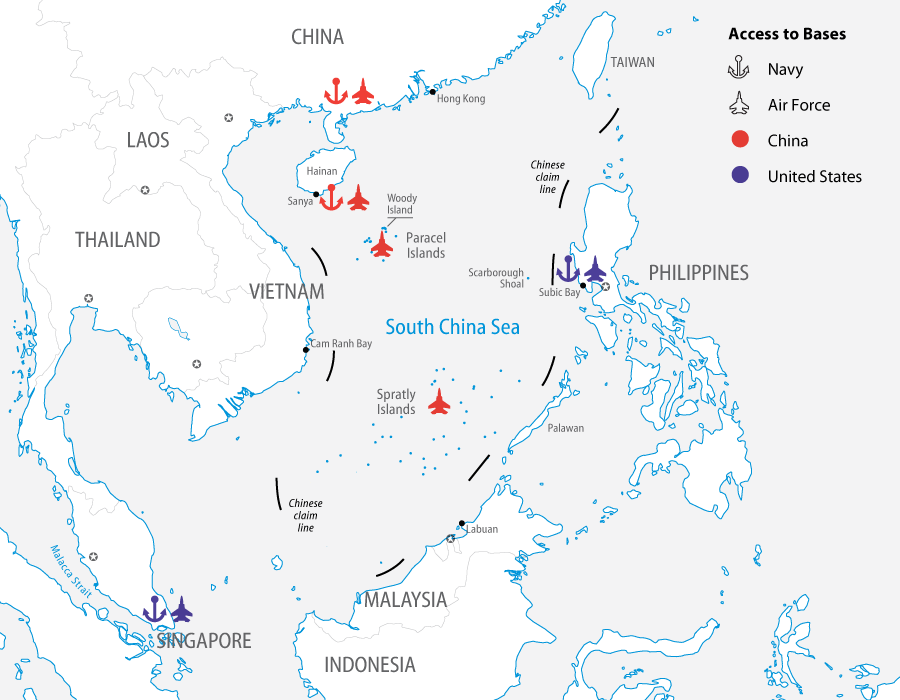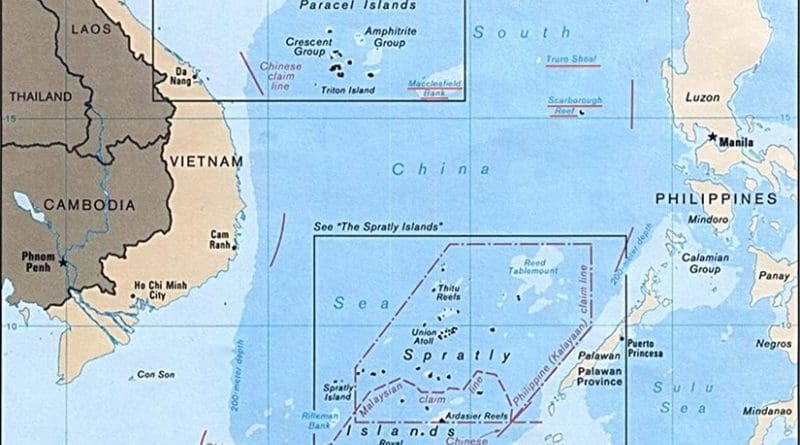South Sea Escalation: Relations Between China And The US – Analysis
By Published by the Foreign Policy Research Institute
By Felix K. Chang*
Every week that passes seems to bring a new development in the South China Sea. Over the last few months, China finished the construction of military-grade airfields on several of the islets that it occupies in the Spratly archipelago and began building radar installations on them. It also deployed HQ-9 surface-to-air missile systems and combat aircraft to the Paracel Islands.
Meanwhile, the United States twice sailed a guided-missile destroyer close to Chinese-held islands and flew a pair of B-52 bombers nearby to assert freedom of navigation through the area. It also began to monitor the region with P-8A maritime patrol aircraft. Possibly even more worrisome to China, the United States has begun to discuss conducting joint patrols in the South China Sea with not only the Philippines, a country that disputes China’s claims, but also India, one of China’s Asian rivals. Yesterday, the U.S. Pacific Command announced that it would hold a joint naval exercise with India and Japan, China’s other Asian rival, in the waters just north of the South China Sea later this year.[1]

While tensions have rapidly risen in recent months, the escalation in words and actions between China and the United States started years ago. Many Chinese cite 2010 as a turning point. During that year’s ASEAN Regional Forum, Southeast Asian leaders publicly rebuked China over its assertiveness in the South China Sea. Not believing that they would do so on their own accord and witnessing then U.S. Secretary of State Hillary Clinton’s behavior at the forum, China came to believe that the United States orchestrated the criticism. From that, China concluded that the United States had abandoned its long-held position not to take sides in the South China Sea dispute and had chosen to interject itself into it.
Certainly by late 2014, the United States had decided to challenge China’s actions. Diplomacy had failed to deter China from incrementally elbowing its Southeast Asian neighbors out of the South China Sea. Indeed, China had become even more assertive, violating the spirit of the ASEAN code of conduct that it signed in 2002. Rather than refraining from actions that may change the status quo, China stepped up its military presence, increased the number of its coast guard patrols, and even encouraged its fishermen to fish in the South China Sea with subsidized fuel. That eventually led to a months-long standoff between Chinese and Philippine naval vessels near Scarborough Shoal in 2012.
Despite the risk of such incidents, both China and the United States have good reasons to stand firm. First and foremost, Beijing believes that the islands in (and possibly the waters of) the South China Sea are its own. Plus, Beijing knows that no Southeast Asian country without American support can prevent it from dominating those waters. Chinese observers also have cause to question how strong that American support really is. Over the last half decade or so, the United States has proven itself to be diffident whenever it has been confronted with an international crisis, from the Middle East to Eastern Europe. However vigorous American rhetoric might sound, Beijing may believe that if push came to shove, the United States would back down.
On the other hand, Washington believes that it must ensure freedom of navigation through the South China Sea, not only for the sake of international norms, but also to shore up the credibility of its security commitments in Asia, which have been dented by its past prevarications. Ultimately, those commitments help to underpin the prevailing international order, which China occasionally chafes against. But many American observers wonder whether China would really challenge that order, not least of which because China has so greatly benefited from it. Why risk upsetting it now, especially when China’s economy is teetering. Surely, Chinese leaders, whose primary interest has always been to stay in power, are more concerned about the rising unrest inside China than the South China Sea. However confrontational China may seem, Washington may believe that if push came to shove, China would back down.
All of this would be even more alarming were it not for Sino-American cooperation in other areas, such as this week’s United Nations sanctions on North Korea. But how far apart the two countries are on the South China Sea was made clear in February when the United States openly warned China of “consequences” if it did not heed the decision of an arbitration court in The Hague where the Philippines brought a legal case against China over its South China Sea claims. That divide was again evident at a press conference last week during which U.S. Secretary of State John Kerry and Chinese Foreign Minister Wang Yi, while standing next to one another, cautioned each other’s country not to take further provocative actions in the South China Sea. Neither diplomat appeared to acknowledge the other’s caution. As most observed, it seemed as if they agreed to disagree.
Days later, the heated rhetoric between China and the United States resumed. At a Congressional hearing, Admiral Harry Harris, commander of the U.S. Pacific Command, testified that “China seeks hegemony in East Asia.” In response, Chinese Foreign Ministry spokesperson Hong Lei accused the United States of “maritime hegemony and muscle-flexing on the sea.”[2] Neither comment raised many eyebrows. Perhaps that is because we have become inured to the rhetorical exchanges. But the longer the escalation of words and actions continues, the higher the stakes will be if an incident does occur. It will be harder for China and the United States to back down without real costs. But thus far neither side seems in the mood for compromise.
About the author:
*Felix K. Chang is a senior fellow at the Foreign Policy Research Institute. He is also the Chief Strategy Officer of DecisionQ, a predictive analytics company in the national security and healthcare industries. He has worked with a number of digital, consumer services, and renewable energy entrepreneurs for years. He was previously a consultant in Booz Allen Hamilton’s Strategy and Organization practice; among his clients were the U.S. Department of Energy, U.S. Department of Homeland Security, U.S. Department of the Treasury, and other agencies. Earlier, he served as a senior planner and an intelligence officer in the U.S. Department of Defense and a business advisor at Mobil Oil Corporation, where he dealt with strategic planning for upstream and midstream investments throughout Asia and Africa.
Source:
This article was published by FPRI.
Notes:
[1] Sanjeev Miglani, “U.S. plans naval exercises with India and Japan in Philippine Sea,” Reuters, Mar. 2, 2016.
[2] “China slams U.S. admiral’s South China Sea remarks,” Xinhua, Feb. 26, 2016.


It is true. No SE Asian nation can prevent China from dominating the South China Sea w/o US support.
And the Chinese have demonstrated clearly by their actions that its smaller neighbors will be bullied and coerced
as China sets itself up as the regional hegemony.
China cannot fool the world this time.
China doesn’t own the South China sea and building those 7 fake islands doesn’t prove that China owns the South China sea.
China’s actions in South china sea contested area were in serious provocation, unlawful, and irresponsible.
China is a master of DOUBLE TALKING. The world should not trust and believe on any of China’s good words.
China is playing blaming game with the US so as the World will not see China as the sole instigator in SCS by building seven fake islands.
China always saying that the construction work in seven fake islands were purely for civilian use but now the world is seeing its true intention in South china sea.
China is very ADAMANT of claiming most of South china sea by force and needed to control it…. by building seven fake islands in SCS contested area and militarizing it.
China was “changing the operational landscape” in the South China Sea by deploying missiles and radar as part of an effort to militarily dominate East Asia.
China even block small fishermen close to the contested area and kill their livelihood.
The USA and the world must unite to stop this unlawful and provocative behavior of China in SCS contested area.
SOUTH CHINA SEA MUST GOVERN BY LAWS NOT CHINA’S MIGHT.
China is just a bully, greedy, selfish and deceitful country.
yesterday – and therefore not included for analysis in this very well presented article by Mr. Felix Chang – the USA ordered a complete aircraft carrier squadron to the South China Sea. This may be for the “war games” with India mentioned by Mr. Chang. Or, it may be for something else.
// The article mentions “China economy teetering”…this is very significant for any prediction of military action by China. Due to the internal tension within China government between very hawkish military factions and the civilian Communist Party business + economic leadership, ANY shift in balance caused by a downturn in China economic power will yield an increase in military assertiveness. The article doesn’t look at this barometer of measurement. This is why I think China should be happy that Donald Trump is running for President of the USA with a view to shift US policy away from the Hillary Clinton militarist response, toward a more business approach to diplomatic problems.// Finally, I cannot imagine the USA going over to the South China Sea and destroying or de-occupying those artificial islands WITHOUT a prior court ruling from the Hague…(although the US never abides by negative rulings from the Hague)that the islands have no justification in international law. However, with the 2016 Presidential election looming ever closer, and “the permanent government” of Military/Intelligence/Oil interests concerned of losing control over policy if Donald Trump wins, we might be looking at long term game-changing military action by the USA in the South China Sea.